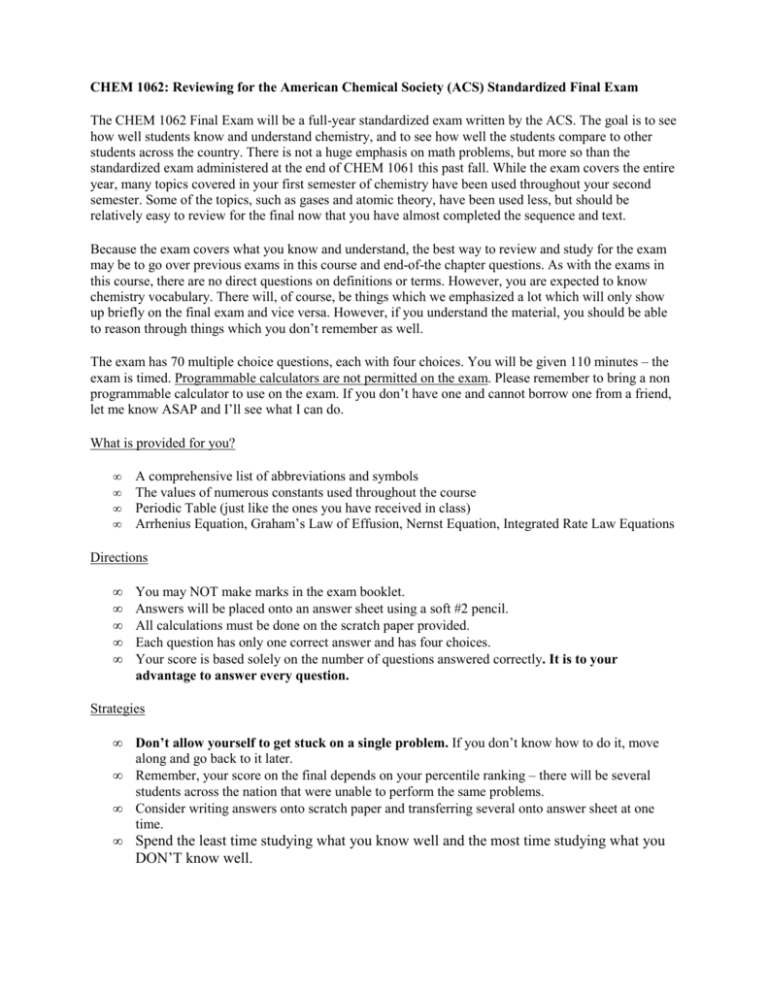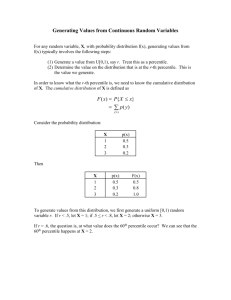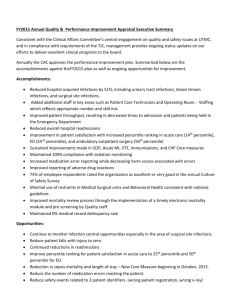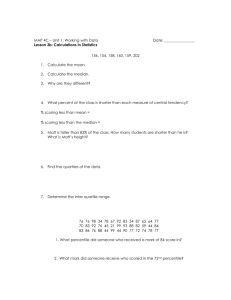Reviewing for ACS Final Exam
advertisement

CHEM 1062: Reviewing for the American Chemical Society (ACS) Standardized Final Exam The CHEM 1062 Final Exam will be a full-year standardized exam written by the ACS. The goal is to see how well students know and understand chemistry, and to see how well the students compare to other students across the country. There is not a huge emphasis on math problems, but more so than the standardized exam administered at the end of CHEM 1061 this past fall. While the exam covers the entire year, many topics covered in your first semester of chemistry have been used throughout your second semester. Some of the topics, such as gases and atomic theory, have been used less, but should be relatively easy to review for the final now that you have almost completed the sequence and text. Because the exam covers what you know and understand, the best way to review and study for the exam may be to go over previous exams in this course and end-of-the chapter questions. As with the exams in this course, there are no direct questions on definitions or terms. However, you are expected to know chemistry vocabulary. There will, of course, be things which we emphasized a lot which will only show up briefly on the final exam and vice versa. However, if you understand the material, you should be able to reason through things which you don’t remember as well. The exam has 70 multiple choice questions, each with four choices. You will be given 110 minutes – the exam is timed. Programmable calculators are not permitted on the exam. Please remember to bring a non programmable calculator to use on the exam. If you don’t have one and cannot borrow one from a friend, let me know ASAP and I’ll see what I can do. What is provided for you? • • • • A comprehensive list of abbreviations and symbols The values of numerous constants used throughout the course Periodic Table (just like the ones you have received in class) Arrhenius Equation, Graham’s Law of Effusion, Nernst Equation, Integrated Rate Law Equations Directions • • • • • You may NOT make marks in the exam booklet. Answers will be placed onto an answer sheet using a soft #2 pencil. All calculations must be done on the scratch paper provided. Each question has only one correct answer and has four choices. Your score is based solely on the number of questions answered correctly. It is to your advantage to answer every question. Strategies • • • • Don’t allow yourself to get stuck on a single problem. If you don’t know how to do it, move along and go back to it later. Remember, your score on the final depends on your percentile ranking – there will be several students across the nation that were unable to perform the same problems. Consider writing answers onto scratch paper and transferring several onto answer sheet at one time. Spend the least time studying what you know well and the most time studying what you DON’T know well. Things you are expected to know (items in italics are first-semester topics): • • • • • • • • • • • • • • • • • • • • • basic chemistry vocabulary/terminology (Look at the end of each chapter for Important Terms given in bold) intermolecular forces, lattice energy, phase transitions, relation of b.p. and m.p. to intermolecular forces, phase diagrams, types of solids, unit cell calculations types of solutions, solution concentrations (molarity, molality, %, mole fraction), solubility curves, colligative properties, colloids, solubility curves for gases vs. curves for solids kinetics, experimental determination of rate, determining the rate law using the initial rate method, rate constants, elementary reactions, catalysis, reaction mechanisms, collision & transition state theory, activation energy, concentration-time calculations, temperature and rate, half-lives, graphical determinations of reaction order and rate constant, potential energy diagrams chemical equilibrium, equilibrium constant, reaction quotient, LeChatlier’s Principle, predicting reaction direction, calculating equilibrium concentrations, ICE tables acid-base theories: Arrhenius and Bronsted-Lowry, acid-base strength and relation to molecular structure, self-ionization of water, and pH , strong and weak acids and bases acid & base ionization equlibria, polyprotic acids, salt solutions, common ion effect, buffers, titration curves solubility product constant, common ion effect, pH and solubility, precipitation calculations, solubility rules, particularly for ions for which there are no exceptions to the rule 2nd & 3rd laws or thermodynamics, entropy and ∆S, free energy and ∆G, spontaneity, relation to the equilibrium constant, work, state function, extensive property, enthalpy and ∆H, Hess’s Law, specific heat capacity balancing redox reactions, voltaic and electrolytic cells, cell notation, emf, Ecell, electrode potentials, oxidation numbers (know your rules), oxidizing and reducing agents, strength of these agents, applications of electrochemistry, electrolysis fission, fusion, radioactivity, nuclear bombardment reactions, radioactive decay, half-lives, massenergy calculations, isotopes and nuclide symbols, mass numbers and atomic weights, subatomic particles chemical/physical change/properties, significant figures, SI units and prefixes nomenclature – polyatomic ions and Greek prefixes, molecular compounds, ionic compounds, acids, binary compounds, ion charge based on position in periodic table, diatomic elements completing and balancing combustion and double replacement reactions, net ionic equations, spectator ions, molecular equations, gas-producing reactions basic stoichiometry – molar masses, molar ratios, limiting reactant, percent composition, molarity, percentage yield, empirical and molecular formulas gas laws: empirical, ideal, effusion, partial pressures, STP, kinetic-molecular theory, barometers and manometers energy, frequency, and wavelength, emission spectra, electron configurations, orbital diagrams, quantum numbers (n, l, ml, ms) periodic trends (atomic radii, ionization energies, electronegativities, ionic radii) Lewis structures, resonance, formal charges, bond polarity, exceptions to octet rule, bond order VSEPR model: hybridization, polarity of molecules, lone pairs, bonding pairs, σ and π bonds L ⋅ atm g/cm3 may be written as g·cm-3 and may be written as L·atm·mol-1·K-1 mol ⋅ K Know the following equations: d= m V ∆Hº = Σn∆Hºf(products) - Σn∆Hºf (reactants) M 1 V1 = M 2 V2 ∆Gº = Σn∆Gºf(products) - Σn∆Gºf (reactants) PV = nRT ∆Sº = Σn∆Sº(products) - Σn∆Sº (reactants) q = m×s×∆T ∆Tf = Kfcm and ∆Tb = Kbcm Calculating Molarity, molality, %, mole fraction Formulas for equilibrium constant and reaction quotient P1V1 P2V2 = T1 T2 [H3O+][OH-] = Kw = 1.0×10-14 q (system) = -q (surroundings) pH = -log[H3O+] ∆Go = ∆Ho + T∆So pOH = -log[OH-] ∆Go = -RT ln K pH + pOH = 14.00 ∆Go = -nFEocell pH = pKa + log Eocell = t1/2 = ln 0.0592 log K n 0.693 k Nt = -kt N0 K aK b = K w Rate = kNt ∆E = (∆m)c2 [base] [acid] How Your Final Exam Score Will Be Determined The table below shows how raw scores on the ACS exam will be converted to scaled final exam scores. The ACS standardized exam has 70 questions, two of which are on material we did not cover over the course of two semesters (resulting in a slight adjustment from the national norms). In the event you are unfamiliar with how percentiles work, an 84th percentile means that you scored higher than 84% of the students on the national norms and a 25th percentile means that you scored higher than 25% of the students taking the same exam on the national norms. Students scoring in the 80th to 100th percentile will be assigned an "A" score on the final, the 60th to 79th percentile will be assigned a "B", the 40th to 59th percentile will be assigned a "C", the 20th to 39th percentile will be assigned a "D", and the 0th to 19th percentile will be assigned an "F". Raw Score Percentile Ranking Scaled Percentage Scaled Final Exam Score Raw Score Percentile Ranking Scaled Percentage Scaled Final Exam Score 70 69 68 67 66 65 64 63 62 61 60 59 58 57 56 55 54 53 52 51 50 49 48 47 46 45 44 43 42 41 40 39 38 37 36 35 100 100 100 100 100 100 100 99 99 99 98 97 96 95 94 92 91 89 88 86 82 78 76 72 69 66 63 60 56 53 50 47 43 40 37 34 100 100 100 100 100 100 100 99.5 99.5 99.5 99 98.5 98 97.5 97 96 95.5 94.5 94 93 91 89 88 86 84.5 83 81.5 80 78 76.5 75 73.5 71.5 70 68.5 67 200 200 200 200 200 200 200 199 199 199 198 197 196 195 194 192 191 189 188 186 182 178 176 172 169 166 163 160 156 153 150 147 143 140 137 134 34 33 32 31 30 29 28 27 26 25 24 23 22 21 20 19 18 17 16 15 14 13 12 11 10 9 8 7 6 5 4 3 2 1 0 31 27 25 22 19 17 14 12 10 9 7 6 4 3 2 2 1 1 0 0 0 0 0 0 0 0 0 0 0 0 0 0 0 0 0 65.5 63.5 62.5 61 59.5 58 55 54 52 50 48 47 46 45 44 43 42 41 40 39 38 36 34 31 28 25 23 20 17 14 11 8 5 2 0 131 127 125 122 119 116 110 108 104 100 96 94 92 90 88 86 84 82 80 78 76 72 68 62 56 50 46 40 34 28 22 16 10 4 0








